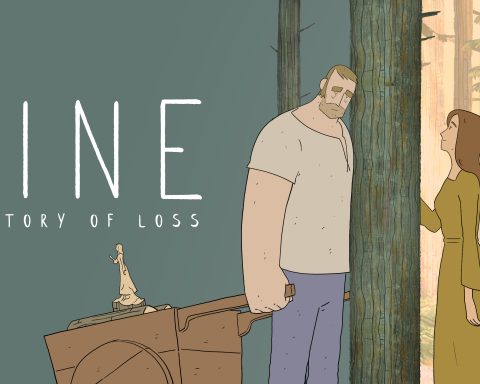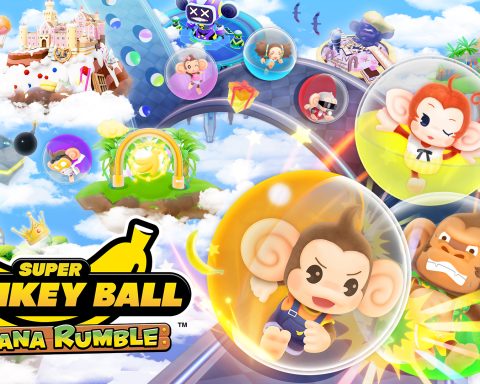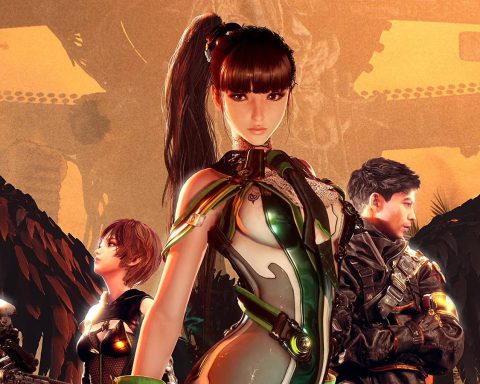Feature by Matt S.
It must be hard to make a game based on the aesthetics, approach to storytelling, and design of opera. It must be really, really hard. Games and film are common bedfellows. There’s plenty of literature that has been adapted into video games, as well. Every art movement that you can imagine – impressionism through surrealism, modernism through minimalism, has had a direct impact on video games.
But opera? Opera and video games are a tough sell. There’s plenty of reasons for that, of course. On a purely practical basis, the crossover between audiences can’t be that great; the typical gamer baulks at the cost of a video game… they should see what a night at the opera will set you back. More significantly, though, the two art forms have an almost polar opposite approach to audience engagement. Opera is a steep mountain of meaning to climb, and even if you can look past the fact that most operas aren’t even in English, the dense symbolism, metaphor, and layered meaning is precisely why that particular form of art isn’t of mainstream interest. Video games, as the pre-eminent entertainment form of our generation, rely heavily on literal meaning and instantly accessible storytelling.
On the flipside, the one thing you can be sure that opera audiences don’t look for in their entertainment is visceral thrills, and yet that’s almost the exclusive foundation of almost any popular videogame.
And yet there is such beauty in opera; in the way it tells its stories, and in its aesthetics, tone, and themes, that has meant it has always been of interest to me, as one of the relatively few “gamers” that also happily splashes out for tickets to watch Carmen. I’ve always been fascinated at the idea that opera might inspire game developers. And there have been a couple of attempts – often critically panned, rarely remembered beyond a tiny community – but they are there.
At this point I’ll note that for the rest of this article I’m not going to talk about the music of opera. Of course, opera is all about music, but there’s a difference between a game having operatic music, and a game taking on the narrative, aesthetic and thematic design of opera to be a truly operatic game. There are a lot of games that have operatic music in them, but very few games that can genuinely claim to be an opera in themselves.
The most obvious instance of opera in a video game that we’ve seen is that memorable scene in Final Fantasy VI, where Celes takes on the role of one of the doomed lovers in the performance to help foil a plot that the baddies are masterminding in the background. That performance is presented as something of a break from the rest of the game; there’s no combat, and there’s not even any character development, since at that moment Celes is just playing a role. Sure, you can argue that the melancholic tragedy of the story mirrors her own story of melancholy and woe, but other than making the scene believable (i.e. she’s got life experience to draw on here), it’s a memorable and emotive interlude that is somehow held distinct from the rest of the game. As though the developers were uncomfortable with the idea of tackling opera in a video game themselves.
Even the boss of that particular scene was there as the comic relief baddie and only related to everything else going on in the world in the most abstract sense. That opera scene would be DLC in the modern environment, for sure. And so, while Final Fantasy VI has the most recognisable “opera” moment that we’ve seen in video games to date, it’s not really the game we’ll be starting this journey with, in charting the influence of opera in video games.
The first actual opera game
As far as I can tell, the first game to make “opera” central to its design brief is a largely forgotten masterpiece called Chaos Legion (yes, masterpiece. You all are going to be shocked when an unexpected sequel makes you redefine the original like you did with NieR). Back in the PlayStation 2 era, Capcom was running hot to publish creative, risky ideas. It brought us stuff like Killer7 and Viewtiful Joe, and after hitting it big with Devil May Cry, was also keen on publishing other action-heavy modern brawlers.
Chaos Legion was one such attempt. The developer even went out there into the media to specify that their game was indeed designed to be an out-and-out opera. Not just in terms of the music, but the sense of drama and thematics as well.
Superficially the game resembled Devil May Cry in the way that level design and boss battles worked. However, this game’s quirk was that the protagonist was only marginally useful in combat, and his real strength was his ability to “summon” some allies that would form a ring around him and do most of the fighting for him. There were a bunch of different allies to unlock and level up, and all of this was in the context of a heavily gothic design, which led itself masterfully to the classical opera tone of the storytelling.
These allies were named after powerful emotions or actions, such as “Guilt,” “Hatred”, “Arrogance”, “Blasphemy” and so on. This, too, fitted well with the opera concept. Because opera storytelling is done principally through verse (and then, often in a language the audience doesn’t understand), characters tend to exhibit extreme characterisation that makes their motivations and personalities clear and easy to follow, regardless of whether you, the person in the audience, is making sense of what is being said (or, specifically, sung). Opera’s delivery style is overly dramatic and exaggerated in order to really drive home the emotion and meaning of the performance, so in using such strong words to describe the protagonists’ allies, Chaos Legion establishes that tone of angst and violence to support the often disjointed and minimalist approach to cut scenes and storytelling.
Additionally, morality in opera tends to be quite black-and-white, and many of the artists that worked in opera designed characters to represent a single virtue or vice. This is certainly true in Chaos Legion with those legions each literally named after a single vice. As far as narrative development goes, the semi-morality play approach of opera gives its storytelling a unique tone, and the developer of Chaos Legion absolutely nailed that tone.
Chaos Legion was absolutely panned on release. The Metacritic rating for the superior PlayStation 2 version sits at just 65 per cent, and in many cases the reason critics gave was that, as the game had a superficial resemblance to Devil May Cry, but didn’t perform like it, it was therefore a poor game. If any game ever needed to be analysed in the context of the operatic themes, it was this one. That’s not to say it would have ever been a game that resonated with the mainstream (because opera will never be mainstream itself), but I certainly can’t think of too many other PlayStation 2 games that have really stuck with me quite like Chaos Legion. Conceptually it was an absolute masterpiece, and the game was structured in a way to support that concept. It didn’t play as well as Devil May Cry, but it was missing the point by a wide margin to criticise it for that.
Why “operatic” game design struggles to resonate
Pandora’s Tower, released on the Nintendo Wii, is another game I’d call operatic, though in this instance I think it’s more a consequence of the approach the developers took to the game than a deliberate vision by anyone on the creative team to “do opera.” If you study opera, one of the terms you’ll quickly become very familiar with is leitmotif, which refers to “short, constantly recurring musical phrase.” Much of theory in opera centres around how the composers either worked with, or subverted the concept of a leitmotif in building the drama and performative qualities in their work.
Pandora’s Tower is a game whose entire concept also spins around a short, constantly recurring action. Players need to constantly harvest the hearts of monsters and bring them back to a (vegetarian) woman, who must chow them down raw in order to stave off a horrific disease. The game is deeply tragic, filled with dramatic irony (vegetarians forced to eat meat in the most grotesque manner), and melancholic in visual design and tone. In other words, it takes the core components that denote a video game (“gameplay”) and structure them in the same way that an opera takes its core components – the music – and structures its narratives.
Pandora’s Tower was the third of three JRPGs that become a loose collection after they were all announced at roughly the same time, and Nintendo initially passed on the opportunity to localise them (the other two were Xenoblade Chronicles and The Last Story). Of the three, it is the one that performed the weakest both with critics and in the market after concentrated campaigning by fans convinced Nintendo to reverse that decision.
Part of the reason that the game didn’t resonate was almost certainly that structure. According to videogame standards, “repetition” is considered an inherent negative, and games need to prove the need to be repetitious. It’s hard for a game to then do that when the reason for the repetition isn’t necessarily going to be understood by the audience. In opera, the leitmotif is an expected element, but then the audience knows to expect that, and appreciates the reason for it being there. Of that “trilogy” of games, I thought Pandora’s Tower was leagues ahead of the other two, both of which aimed for far more traditional, “safe” fantasies as far as game and thematic design goes.
The continued influence of Chaos Legion
The most recent examples of games with explicit associations to opera are Koei Tecmo’s Nights of Azure titles. Both games are more literal in their interpretation of opera – actual scenes in opera houses, over-the-top melancholia and a relentless focus on the “tragic lovers” theme – so again, while the developers never came out to say it, the two Nights of Azure titles owe a lot to the aesthetics and tone of the opera.
Interestingly – and again I don’t know if this was deliberate or coincidence – but the games also share a lot in common with Chaos Legion. Especially the first. Just like in Chaos Legion, the central hero is competent in combat, but much stronger when she summons several helpers to do her fighting for her on the battlefield. Just like in Chaos Legion these helpers all have their own unique skills, and can be levelled up so that you can build a team that really suits your combat style. I remember being taken aback when I first played the first Nights of Azure, because I immediately recalled Chaos Legion when I started playing. A game I haven’t played in over a decade.
Perhaps there’s something in that. Perhaps the melancholic tone of the opera requires that players can’t be in control of an all-consuming hero, and the helpers in these games are a mechanical reflection of that. Perhaps it’s another subtle leitmotif, in that the process of swapping between monsters to summon them into battle is both repetitive and rhythmical in design.
Nights of Azure and its sequel were, as with the others, generally panned and relegated to super-niche status from launch. In the case of those games, it tended to be the sexualisation and “limited” narratives that were the points of contention, though here too, sex has been a theme in heavy rotation in opera, and when you boil Nights of Azure’s two games down, they’re both not so different to that classic scene in Final Fantasy VI; they are sad stories of love and impending, inevitable loss. Nights of Azure uses sex as a narrative tool to deepen the bond between the characters, and through that the emotional weight of the impending tragic inevitability.
Whatever the reason, it’s fascinating that of the tiny few games that we have that can genuinely be considered to be operatic, there’s such strong common threads between so many of them; they’re Japanese-developed action JRPG games that share thematic notes and a specific approach to the action. Whether that’s because the game developers are drawing on what is common knowledge with regards to opera, rather than taking the time to really understand it, or it’s because this is perhaps the only way to adapt opera to videogames remains to be seen.
We need more developers tackling opera as a subject and muse; it’s a beautiful art form, and it could be used to create truly distinctive games in the hands of the right kind of developers.
– Matt S.
Editor-in-Chief
Find me on Twitter: @digitallydownld
 |
| Please Support Me On Patreon!
|










